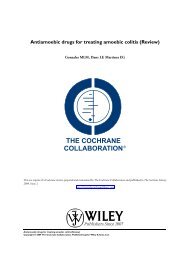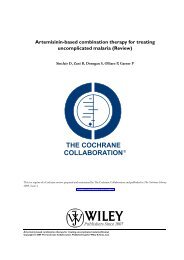Interventions for treating proximal humeral fractures in adults (Review)
Interventions for treating proximal humeral fractures in adults (Review)
Interventions for treating proximal humeral fractures in adults (Review)
Create successful ePaper yourself
Turn your PDF publications into a flip-book with our unique Google optimized e-Paper software.
T A B L E O F C O N T E N T S<br />
HEADER . . . . . . . . . . . . . . . . . . . . . . . . . . . . . . . . . . . . . . . 1<br />
ABSTRACT . . . . . . . . . . . . . . . . . . . . . . . . . . . . . . . . . . . . . . 1<br />
PLAIN LANGUAGE SUMMARY . . . . . . . . . . . . . . . . . . . . . . . . . . . . . . 2<br />
BACKGROUND . . . . . . . . . . . . . . . . . . . . . . . . . . . . . . . . . . . . 3<br />
OBJECTIVES . . . . . . . . . . . . . . . . . . . . . . . . . . . . . . . . . . . . . 3<br />
METHODS . . . . . . . . . . . . . . . . . . . . . . . . . . . . . . . . . . . . . . 4<br />
RESULTS . . . . . . . . . . . . . . . . . . . . . . . . . . . . . . . . . . . . . . . 7<br />
DISCUSSION . . . . . . . . . . . . . . . . . . . . . . . . . . . . . . . . . . . . . 12<br />
AUTHORS’ CONCLUSIONS . . . . . . . . . . . . . . . . . . . . . . . . . . . . . . . 14<br />
ACKNOWLEDGEMENTS . . . . . . . . . . . . . . . . . . . . . . . . . . . . . . . . 15<br />
REFERENCES . . . . . . . . . . . . . . . . . . . . . . . . . . . . . . . . . . . . . 15<br />
CHARACTERISTICS OF STUDIES . . . . . . . . . . . . . . . . . . . . . . . . . . . . . 19<br />
DATA AND ANALYSES . . . . . . . . . . . . . . . . . . . . . . . . . . . . . . . . . . 35<br />
Analysis 1.1. Comparison 1 Early mobilisation with<strong>in</strong> 1 week versus immobilisation <strong>for</strong> 3 weeks, Outcome 1 Number of<br />
treatment sessions. . . . . . . . . . . . . . . . . . . . . . . . . . . . . . . . . 39<br />
Analysis 1.2. Comparison 1 Early mobilisation with<strong>in</strong> 1 week versus immobilisation <strong>for</strong> 3 weeks, Outcome 2 SF-36 scores:<br />
pa<strong>in</strong> & physical dimensions. . . . . . . . . . . . . . . . . . . . . . . . . . . . . . 40<br />
Analysis 1.3. Comparison 1 Early mobilisation with<strong>in</strong> 1 week versus immobilisation <strong>for</strong> 3 weeks, Outcome 3 Constant<br />
shoulder score (ratio of affected/unaffected arm). . . . . . . . . . . . . . . . . . . . . . . 41<br />
Analysis 1.4. Comparison 1 Early mobilisation with<strong>in</strong> 1 week versus immobilisation <strong>for</strong> 3 weeks, Outcome 4 Shoulder<br />
disability: Croft Shoulder Disability Score. . . . . . . . . . . . . . . . . . . . . . . . . 41<br />
Analysis 1.5. Comparison 1 Early mobilisation with<strong>in</strong> 1 week versus immobilisation <strong>for</strong> 3 weeks, Outcome 5 Croft<br />
Shoulder Disability Score: <strong>in</strong>dividual problems at 2 years. . . . . . . . . . . . . . . . . . . . 42<br />
Analysis 1.6. Comparison 1 Early mobilisation with<strong>in</strong> 1 week versus immobilisation <strong>for</strong> 3 weeks, Outcome 6 Frozen<br />
shoulder. . . . . . . . . . . . . . . . . . . . . . . . . . . . . . . . . . . . 43<br />
Analysis 2.1. Comparison 2 Immobilisation <strong>for</strong> 1 week versus immobilisation <strong>for</strong> 3 weeks, Outcome 1 Reflex sympathetic<br />
dystrophy at 6 months. . . . . . . . . . . . . . . . . . . . . . . . . . . . . . . 43<br />
Analysis 3.1. Comparison 3 Gilchrist bandage versus ’Classic’ Desault bandage, Outcome 1 Problems with bandages.<br />
Analysis 3.2. Comparison 3 Gilchrist bandage versus ’Classic’ Desault bandage, Outcome 2 Fracture displacement by 3<br />
44<br />
weeks. . . . . . . . . . . . . . . . . . . . . . . . . . . . . . . . . . . . . 44<br />
Analysis 3.3. Comparison 3 Gilchrist bandage versus ’Classic’ Desault bandage, Outcome 3 Poor or bad rat<strong>in</strong>g by patient at<br />
fracture consolidation. . . . . . . . . . . . . . . . . . . . . . . . . . . . . . . . 45<br />
Analysis 4.1. Comparison 4 Instructed self physiotherapy versus conventional physiotherapy, Outcome 1 Pa<strong>in</strong> at one year<br />
(scale 0-8: maximum pa<strong>in</strong>). . . . . . . . . . . . . . . . . . . . . . . . . . . . . . 45<br />
Analysis 4.2. Comparison 4 Instructed self physiotherapy versus conventional physiotherapy, Outcome 2 Severe or<br />
moderate pa<strong>in</strong> at 3 months. . . . . . . . . . . . . . . . . . . . . . . . . . . . . . 46<br />
Analysis 4.3. Comparison 4 Instructed self physiotherapy versus conventional physiotherapy, Outcome 3 Requested change<br />
of therapy. . . . . . . . . . . . . . . . . . . . . . . . . . . . . . . . . . . . 46<br />
Analysis 4.4. Comparison 4 Instructed self physiotherapy versus conventional physiotherapy, Outcome 4 Failure of<br />
treatment. . . . . . . . . . . . . . . . . . . . . . . . . . . . . . . . . . . . 47<br />
Analysis 4.5. Comparison 4 Instructed self physiotherapy versus conventional physiotherapy, Outcome 5 Neer’s rat<strong>in</strong>g (0-<br />
100: best) at 3 months. . . . . . . . . . . . . . . . . . . . . . . . . . . . . . . 47<br />
Analysis 4.6. Comparison 4 Instructed self physiotherapy versus conventional physiotherapy, Outcome 6 Active gleno<strong>humeral</strong><br />
elevation (degrees). . . . . . . . . . . . . . . . . . . . . . . . . . . . . . 48<br />
Analysis 5.1. Comparison 5 Reduction and external fixation versus closed reduction, Outcome 1 Treatment failure by 1<br />
month. . . . . . . . . . . . . . . . . . . . . . . . . . . . . . . . . . . . . 48<br />
Analysis 5.2. Comparison 5 Reduction and external fixation versus closed reduction, Outcome 2 Poor or unsatisfactory<br />
function at 1 year (Neer rat<strong>in</strong>g). . . . . . . . . . . . . . . . . . . . . . . . . . . . 49<br />
Analysis 5.3. Comparison 5 Reduction and external fixation versus closed reduction, Outcome 3 Complications. . . 49<br />
Analysis 6.1. Comparison 6 Cerclage or tension band wir<strong>in</strong>g versus conservative treatment (displaced 3 and 4 part <strong>fractures</strong>),<br />
Outcome 1 Complications. . . . . . . . . . . . . . . . . . . . . . . . . . . . . . 50<br />
<strong>Interventions</strong> <strong>for</strong> <strong>treat<strong>in</strong>g</strong> <strong>proximal</strong> <strong>humeral</strong> <strong>fractures</strong> <strong>in</strong> <strong>adults</strong> (<strong>Review</strong>)<br />
Copyright © 2008 The Cochrane Collaboration. Published by John Wiley & Sons, Ltd.<br />
i








